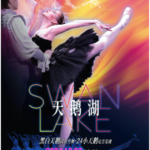Classical ballet Swan Lake is a shining pearl on the crown of ballet art and one of the greatest masterpieces in ballet history. In the nearly sixty years of development history of the Central Ballet, Swan Lake also has an extraordinary significance. In 1876, Tchaikovsky composed the immortal music for the ballet Swan Lake. In 1895, the full-length Swan Lake, co-choreographed by Petipa and Ivanov, premiered by the Imperial Ballet of the Mariinsky Theatre in St. Petersburg, Russia, was a great success, and since then, the play has been recognized as a classic representative of the Russian school, with major ballet companies around the world competing to perform and imitate it. In early 1958, under the guidance of Soviet expert Pyotr Gusev, the Beijing Dance Academy began to rehearse Swan Lake, marking the first time Chinese performed this classic ballet. In June of the same year, Swan Lake finally made its debut on the Chinese stage and was successful. The performance of the first generation of Chinese ballet dancers not only won praise from all sides but also marked the beginning of Western ballet art taking root in the ancient Eastern country. Over the past 60 years, Swan Lake has become a household name in China and a ‘favorite’ among ballet enthusiasts, playing a positive role in the significant development of the Central Ballet. In 1996 and 2003, the troupe bravely explored and launched two new versions of Swan Lake, adapted by Central Ballet artists, which attracted much attention. In 2007, the Central Ballet staged the version of Swan Lake by world ballet superstar Natalia Makarova. In contemporary ballet history, Natalia Makarova is a legendary figure, and some people call her ‘the best ballet star in 50 years’. Makarova’s version of Swan Lake is based on the original by Petipa and Ivanov and incorporates some sections arranged by Sir Frederick Ashton, the choreographer of the Royal Ballet, and is one of the most popular Swan Lakes on the international ballet stage. From the birth of the first ‘White Swan’ to the inheritance of the new generation of ‘White Swans’, from the pioneering of the 1958 premiere version to the exquisiteness of the 2007 ‘Grandma Ma’ version… All these bear the efforts and wisdom of several generations of Chinese ballet artists, showing the continuous development and innovation of China’s ballet career. Production: Central Ballet. Chief Planner/Producer: Zhao Rujing. Music: Pyotr Ilyich Tchaikovsky. Concept and Direction: Natalia Makarova. Choreography: Natalia Makarova (based on the original by Marius Petipa and Lev Ivanov). Other sections choreographed by: Natalia Makarova and Sir Frederick Ashton. Set Design: Peter Farmer. Costume Design: Galina Solovyeva. Lighting Design: Han Jiang. Foreign Chief Rehearsal: Olga Evreinova. Chinese Chief Rehearsal: Zhu Yan, Xu Gang. Production Coordinator: Dina Makarova. World Premiere: March 4, 1877, by the Bolshoi Ballet, Moscow. Central Ballet’s premiere: June 30, 1958, at the Beijing Tianqiao Theater. Natalia Makarova’s version Central Ballet’s premiere: April 30, 2007, at the Beijing Tianqiao Theater. Performance: Central Ballet. Artistic Director: Feng Ying. Performance: Central Ballet Symphony Orchestra. Stage Art: Central Ballet Stage Art Department. Act I: The eve of Prince Siegfried’s coming-of-age birthday party, Benno is leading the prince’s companions in preparations, and they are celebrating in their own way.
The prince arrives and soon blends in among his friends, dancing joyfully. Suddenly, the queen mother arrives, and the lively scene is unexpectedly interrupted. She calls her son aside. She insists that as the prince is about to come of age, he must assume royal responsibilities. She presents the prince with an emblem, a symbol of royal power. As the future king of a country, his own marriage is one of the important matters he must consider first. Siegfried pleads with his mother, but the queen mother reminds him that he has the responsibility to choose a fiancée at the evening party. His mother’s words weigh heavily on the prince’s heart. He feels infinite sadness, both for the lost freedom and for not having met someone who can touch his soul yet.
At dusk, the prince is still lost in troubled thoughts. Benno sees a group of swans flying by in the distance and urges Siegfried to go hunting together, hoping to divert his attention and dispel his melancholy and worries. Siegfried runs into the forest, and Benno follows closely behind, but they take different paths.
Siegfried wanders alone in the depths of the dense forest. He discovers a mysterious lake shrouded in moonlight. The prince knows nothing that this is the demon’s territory. The demon has cast a spell on the maidens, turning them into swans. Siegfried sees a swan gliding across the lake. He is about to shoot her with his bow and arrow. When the swan reaches the shore, he is stunned. Suddenly, the swan turns back into a human form. Her beauty conquers the prince. She is Odette, the queen of the swans who has been enchanted by the demon. Despite being frightened, Odette tells the prince about her plight. The spell turns her and her companions into swans during the day and only allows them to turn back into maidens at night. Only when a man who has never been in love vows to be forever faithful to her can the spell be broken. From the first moment the prince and Odette meet, the prince realizes how right he has always been to believe that true love exists in the world. He has never given his heart to anyone before, but at this moment he unhesitatingly gives it to Odette. As dawn breaks, the demon uses his magic power and snatches Odette from Siegfried’s embrace. Siegfried realizes that his fate is closely intertwined with Odette’s.
Act II
The guests arrive one after another at the ballroom to congratulate Prince Siegfried on coming of age. After the queen mother enters, she finds that Siegfried is not here and she is very uneasy. Soon Siegfried arrives, but he is completely absorbed in his own thoughts. Three knights introduce several fiancée candidates to everyone. Siegfried dances politely with each girl, but in his heart he vows to Odette that no matter how his mother insists, he refuses to choose a fiancée.
Suddenly, a stranger appeared, a knight in disguise, accompanied by the enchanting yet cunning Odile. Her appearance was strikingly similar to Odette, the one the prince deeply loved. Odile cast a spell on the prince, dispelling all his doubts about her identity, and the prince was convinced that she was Odette. He announced his choice for her to be his bride. The knight interceded, demanding that Siegfried swear his loyalty to Odile, which he gladly did. At that moment, the sorrowful figure of Odette appeared before the prince, and he realized he had been deceived. The triumphant devil and Odile vanished. The prince, deeply sorrowful, ran to the lakeside.
Act Three
At night, by the lake, the swans are plunged into deep sorrow, trapped by a spell that keeps them in the form of swans forever. Through the terrible storm conjured by the devil, Siegfried finds Odette and asks for her forgiveness. Odette forgives him, but she knows nothing can change. Death is the only way to save them; the waves of the lake unite the lovers forever, and the devil’s power is destroyed.
In the distance, the image of Odette and Siegfried moving towards eternal love is presented.
Performing Group: Central Ballet
The Central Ballet (also known as the National Ballet of China) was established in December 1959. The company consists of first-class artistic talents cultivated by professional institutions. With the care and support of all sectors of society, the troupe has been built on a solid foundation of the Russian school and continuously absorbs the strengths of various schools and styles. In addition to introducing and performing a large number of world-class masterpieces such as Swan Lake, Don Quixote, Giselle, Carmen, Eugene Onegin, Firebird, The Little Mermaid, La Bayadere, Cinderella, and Jewels, the company has also created a series of distinctive works with strong national characteristics, such as The Red Detachment of Women, Blessings, Yellow River, Raise the Red Lantern, Peony Pavilion, New Year, Crane Soul, Dunhuang, and The Nine-Colored Deer. They have successfully explored a path for the development and creation of Chinese ballet art that perfectly integrates the classics with the modern, and the national with the global.
For over 60 years, the troupe has achieved remarkable success in talent cultivation, repertoire accumulation, and ballet popularization education. Among them, many artists in ballet, music, and stage design have appeared on the podium of international professional competitions and among world stars. The company has over 200 Chinese and foreign repertoires, some of which have been listed as Chinese artistic classics and international cultural brands.
As a renowned troupe with extensive international influence, the Central Ballet Troupe plays a significant role both as an envoy of cultural exchange and as a showcase of Chinese humanistic spirit. On the other hand, the troupe is actively striving to demonstrate higher standards of performance and better art popularization by ‘going into schools,’ ‘going into communities,’ and ‘going into children’s lives.’ With a spirited demeanor, the troupe upholds the spirit of ‘unity, pragmatism, self-improvement, and hard work’ to realize their century-old dream, following in the footsteps of their predecessors who were dedicated to their cause. The current troupe leader and artistic director is Feng Ying.
The full performance is open from December 5th to December 8th, Thursday to Sunday, with performance times and durations subject to the actual event.
Beijing 2024 Dance Festival: Central Ballet’s Classic Ballet Swan Lake
Classical ballet Swan Lake is a shining pearl on the crown of ballet art and one of the greatest mas[...]









